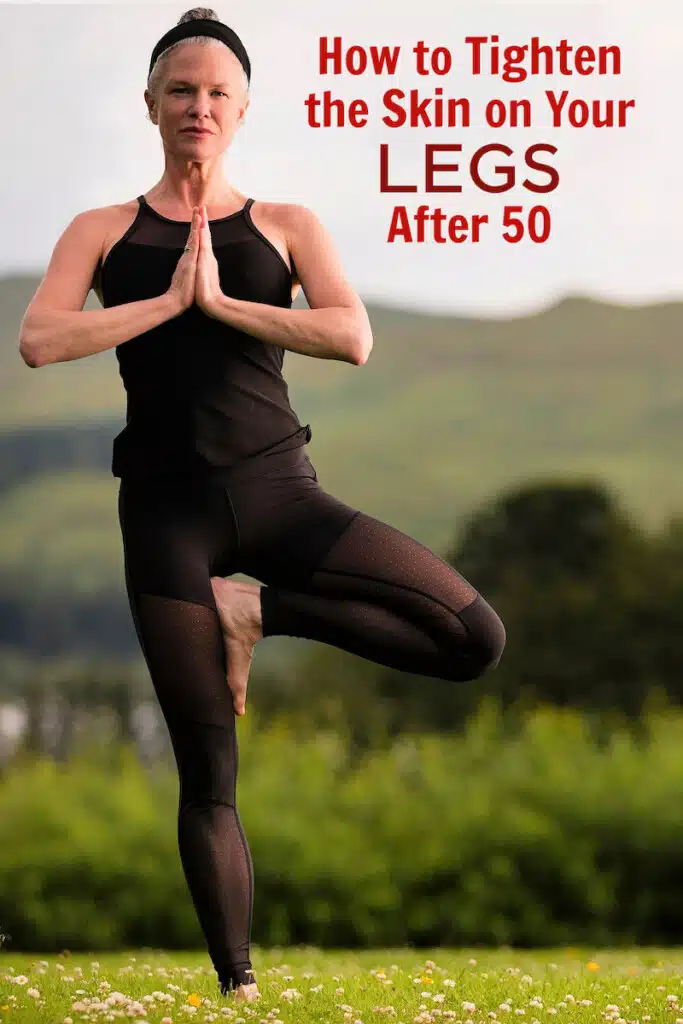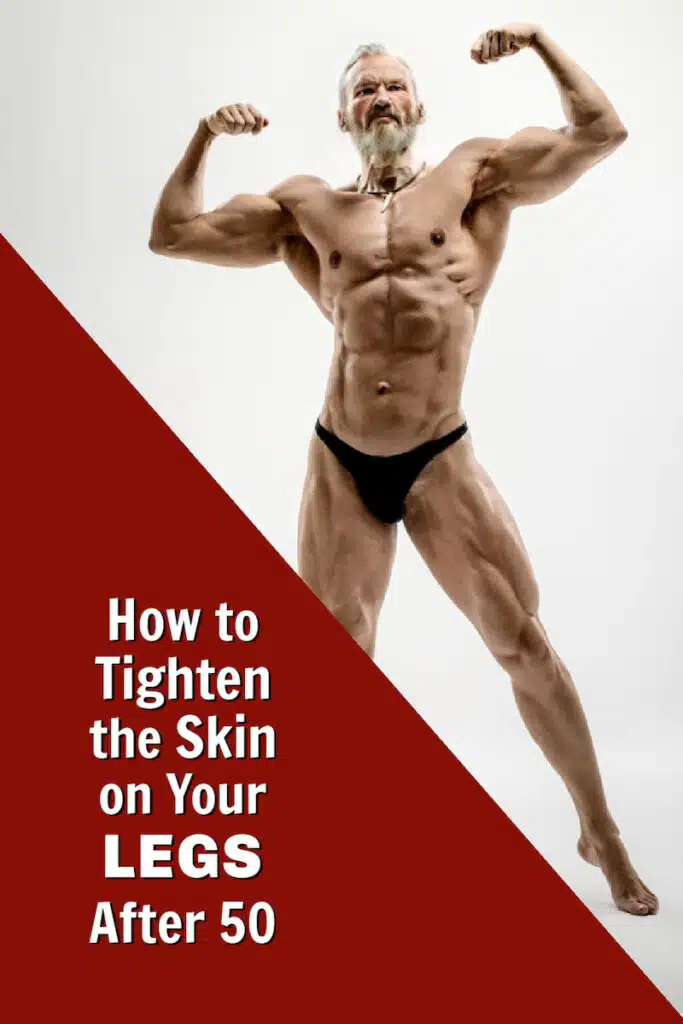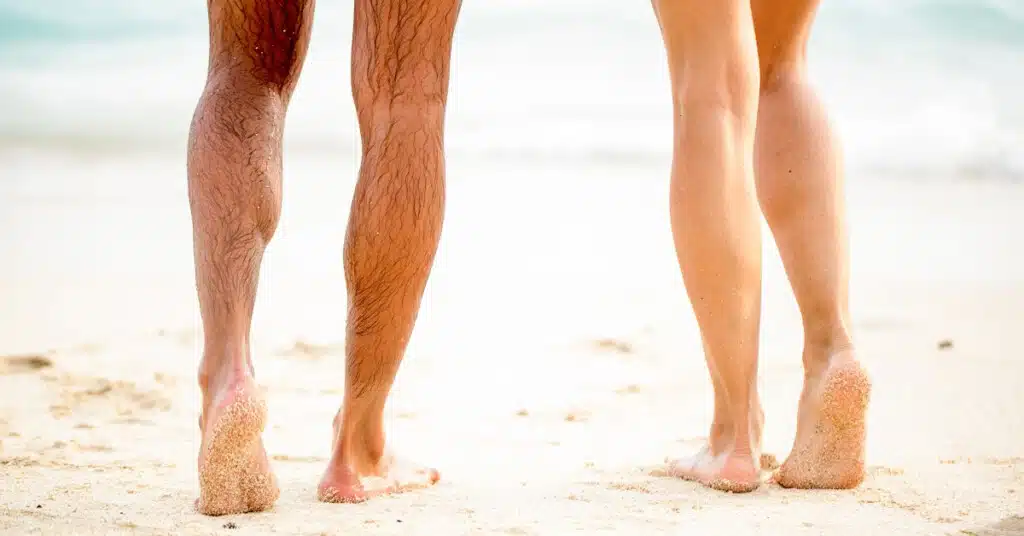Aging changes your body, and for many individuals over 50, sagging skin on the legs becomes a concern. Fortunately, several methods can effectively tighten the skin on your legs.
The following techniques – some lesser-known – help firm and tone the skin on your legs, restoring confidence and promoting a more youthful appearance.
I’m including real-life accounts of techniques I have tried personally – what has worked, and what hasn’t.
What Happens to Leg Skin with Time and Age
The skin directly above the knees is usually one of the first areas to sag.
This is likely from a combination of factors, including genetics.
Everyone’s skin is different. Some people have thick skin, and some have thin skin, like me.
Some people have proportionally longer femur bones, making it harder for the skin to remain taut over such a long area as the decades progress.
Here’s another surprising reason for sagging skin above the knees:
- As you get older, if you keep trim – your body fat percentage at a healthy ratio – you tend to lose subcutaneous fat deposits.
- This is the fat located directly under the skin that helps to “plump up” its appearance.
Frustratingly, visceral fat deposits – the fat that pads itself deeper in between the vital organs – tend to increase.
That means that someone over the age of 50 who eats within their caloric allotment and is athletic might have a difficult time finding any fat to pinch – and yet still have ample organ fat:
- Often, the only place to find any pinchable fat is along the lower back.
- However, the midsection might still look thicker – from a profile view – than it did when you were younger.
- This is because organs tend to grow, and deeper, visceral fat padding tends to increase.

Another reason for loose skin on the legs is extreme weight loss:
- Someone who was obese and who is now trim will have extra skin.
- In younger people who eat very healthily, that loose skin from significant weight loss might tighten up again with time.
- In mature adults, however, extreme weight loss leaves extra skin – most of which will likely be permanent.
Those who have sedentary lifestyles or desk jobs can also have cellulite higher up the legs and on the buttocks – particularly women – but this is different than the sagging skin above the knee.
Cellulite is the dimpled or lumpy tissue that occurs when fat deposits push through the connective tissue beneath the skin, resulting in that characteristic “puckered” texture.
Stretch marks – often from fast weight gain or pregnancy – can also occur – though this, too, is different than the sagging skin above the knee.
Additionally, sun damage can play a role, though this might have more to do with the texture of the skin than the outright sagging.
In any case, I think it’s important to mention that I try to have a sense of humor about aging:
- Of course, I want to look good naked and feel good in my own skin, but I don’t take it too seriously.
- As I get older, I expect to look older.
- Some things I can reverse, some effects I can lessen, and some things I can’t do a darn thing about. And I accept that.
So try the methods below if you want to, but I suggest looking at it like a fun or interesting adventure – and not something overly important in the great scheme of things.
Ways to Get Firmer Thighs with Healthier-Looking Leg Skin
Now for the good news! There are many ways to tighten and lift-up leg skin. However, I’ll start with the three most impactful:
1. Lower-Body Weight Training
Want the skin on your legs to be tauter? Create stronger thigh muscles! Increasing muscle tissue will create firmer skin texture because muscle presses against the skin from the inside, effectively tightening and improving the skin’s appearance.

Squats, lunges, calf heel raises, and leg presses are excellent for building stronger muscles. Aim for at least three weekly sessions, gradually increasing intensity as your fitness improves. This actually works to improve sagging leg skin. I encourage you to experiment with the various lower-body workouts I provide on this site.
2. Clean-Eating Diet (including Ample Hydration)
The healthier you are overall, the more resilient your skin will be and the healthier it will appear.
A diet rich in a broad spectrum of micronutrients (hint: think vegetables!) that also has the ideal ratio of macronutrients – including healthy fats and quality protein – will work wonders to level up the visual youthfulness of your skin. Here, too, I invite you to explore the various recipes and meal plans found on this site.
Most people don’t know they’re having an autoimmune response when they’re having one. And the first area an autoimmune response can negatively impact is the skin. I invite you to consider adopting an anti-inflammatory diet, which can help prevent autoimmune responses within your body.
Include foods rich in collagen-boosting nutrients – such as vitamin C, vitamin E, zinc, and antioxidants. Leafy greens, berries, nuts (almond, pecan, and brazil), sprouted seeds, citrus fruits, and lean proteins like fish can be excellent choices.
Proper hydration is essential for maintaining skin elasticity. Drink adequate water throughout the day to keep your skin hydrated from within. And, if you eat a comparatively lower-carbohydrate diet (which I recommend) and exercise regularly, consider supplementing with electrolytes. Those trace minerals (such as salt, magnesium, and potassium) are crucial to hydration.
As you hopefully already know, it’s wise to avoid excessive alcohol consumption (and cigarettes), as this can contribute to premature skin aging.
To say that your diet plays a vital role in maintaining healthy skin would be a masterpiece of understatement.
3. Strategic Post-Shower Moisturizing Routine
Moisturizing works! There’s a reason that women’s hands and lips tend to look better than men’s. It’s because women have been using lip balm and hand lotion regularly from a younger age. Keeping your skin topically nourished and well-hydrated is essential for maintaining its elasticity.
Choose a high-quality moisturizer formulated explicitly for firming and tightening the skin. Here are some ingredients you can look for on the bottle:
- Hyaluronic acid, shea butter, glycerin, or peptides, can help stimulate collagen production and improve skin texture.
- Look for oils – such as almond, avocado, jojoba, or grapeseed oil – rich in vitamins, minerals, and antioxidants.
- Amino acids are the building blocks of proteins and play a crucial role in maintaining skin health. Look for topical creams or serums containing amino acids such as proline, lysine, and glycine. These amino acids can help boost collagen production and improve skin elasticity.
Wear sunscreen regularly to protect your skin from the sun’s harmful UV rays. I put a second, extra layer of sunscreen on my face – especially my nose, around my eyes, and my ears.
I also use extra sunscreen on my entire neck area.
I was raised as an outdoor kid before the era of sunscreen, so I have sun damage on my neck area, and now as an older adult, I’m extra diligent with my post-shower moisturizing routine.
At night before bed, apply moisturizer again. This time, one that has retinol (retinol and sun don’t mix well, hence the reason it’s a bedtime application).
Retinol is arguably the ingredient with the most proven effectiveness for improving skin youthfulness.
As internal supplements, hyaluronic acid and glycine are affordable and effective, so consider also taking them in pill form (after consulting with a healthcare professional) in the mornings.
Some promising research indicates that other supplements might help skin, too – particularly vitamin A, cocoa extract, coconut oil, nicotinamide, astaxanthin, creatine, rosmarinic acid, and vitamin E – though more human trials are needed.
Additionally, consider incorporating collagen supplements into your diet to support your body’s collagen production from within.
Additional Methods for to Tighten Leg Skin
Once you implement the above top-three methods for tightening leg skin, you might also consider trying these additional methods.
Laser or Radiofrequency Treatments:
In the last few years, skin treatments have advanced considerably! Especially with laser and radiofrequency treatments.
Advanced medical procedures such as laser therapy or radiofrequency treatments can help tighten loose skin on the legs.
When targeting the area just above your knees or elbows, be sure not to do the type of treatment that will reduce fat stores. That’s the last thing you want in these areas.
Instead, ask your dermatologist about other treatments that might suit you and discuss the potential benefits and risks.
Personally, I’ve tried two treatments to tighten my leg skin above the knee. One wasn’t worth it, the other was.
The first treatment I tried involved numbing the area and then making a tiny incision. A narrow wand was inserted and used to massage the underside of the skin. This is supposed to produce collagen. For five days after, I massaged the area five times each day for five minutes each time. My doctor has said this would create a 60% improvement. Hardly. More like 10%, at best. Not worth it.
The other treatment was called ClearLift. It uses light – fractional laser resurfacing – and acoustic soundwaves. The treatment is gentle enough to be pain-free yet potent enough to be effective. It heats the deeper layers of your skin to stimulate collagen and elastin to firm and tighten your skin. No incisions needed and it’s half the cost of the first treatment I tried. I noticed a 20% improvement. I expect it to last at least a year, but I’m going back for another treatment before then.
Compression Garments Can Tighten Skin:
Compression garments can support the legs, improve blood circulation, and reduce fluid retention. These leggings exert gentle pressure on the skin, helping to tighten it and reduce the appearance of sagging. Wear compression garments during the day or physical activity to promote better skin tone and minimize swelling.
Exfoliation and Dry Skin Brushing:
Regular exfoliation can help remove dead skin cells and promote cell turnover, resulting in smoother and tighter skin. Choose a gentle exfoliating scrub or use a dry brush to massage your legs in circular motions gently. Exfoliate your legs once or twice a week to enhance the effectiveness of other treatments and allow them to penetrate deeper into the skin.
Dry skin brushing is an ancient practice using a natural bristle brush to massage the skin in upward circular motions gently. This technique stimulates blood circulation, exfoliates dead skin cells, and promotes collagen and elastin production.
Begin at your feet and gradually work your way up your legs, brushing towards your heart. Aim for five minutes of dry brushing daily before showering for optimal results.
Personally, my skin is too thin and sensitive for dry brushing, but I know other people who swear by it.
Healthier Lifestyle Habits Tighten Skin:
Anecdotally – during over half a century on Earth – I’ve recognized a pattern of good mental health and the healthy appearance of skin.

Adopting a healthy lifestyle can positively impact your overall skin health. Limit your exposure to environmental toxins – and negative people and situations.
Practice making your most habitual thoughts positive.
Conclusion on How to Tighten Skin on the Legs
Aging is a natural process that brings about various changes in your body, including the loss of skin elasticity.
For many individuals over the age of 50, sagging skin on the legs can be a frustration.
To tighten skin on the legs after 50, it requires a multi-faceted approach that combines various techniques. While well-established methods such as regular exercise and moisturization are important, incorporating lesser-known practices like amino acid-based solutions and particular laser treatments can provide additional benefits. Additionally, consider the benefits of compression garments and maintaining a healthy lifestyle.
Remember, consistency and patience are key when implementing these techniques. Embrace the process and allow your legs to regain their firmness, empowering you to feel confident in your skin.
By embracing a holistic approach, you can enhance firmness, feel confident in your skin, and enjoy healthy-looking legs at any age.
Additional Resources on How to Tighten Skin:
Details about the New ClearLift Treatment and Its Abitlity to Tighten Skin – https://alaskacheeky.com/clearlift-a-complete-guide-before-going-for-it/
Indpendent Lab Testing for Brand Supplement Quality – https://labdoor.com/rankings
Research on Effectiveness of How to Tighten Skin with Retinol – https://www.health.harvard.edu/staying-healthy/do-retinoids-really-reduce-wrinkles
